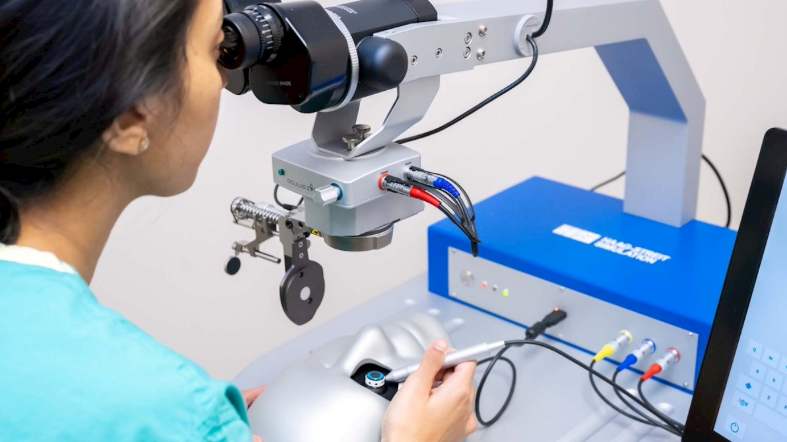Article
Training technology and simulation lab provides ophthalmology residents with valuable experience
Author(s):
With donations, the West Virginia University Department of Ophthalmology and Visual Sciences has added two new pieces of ophthalmic training equipment to its lab.
The West Virginia University Department of Ophthalmology and Visual Sciences recently installed a new EyeSi surgical simulator and Alcon operating microscope in the WVU Eye Institute’s simulation lab. (Image courtesy of West Virginia University)

The addition of two new pieces of ophthalmic training equipment will provide West Virginia University (WVU) Department of Ophthalmology and Visual Sciences residents with the opportunity to receive valuable hands-on training experience prior to working in the operating room.
According to a WVU news release, donations made it possible for the department to purchase a new EyeSi surgical simulator and Alcon operating microscope in 2022, which were both recently installed in the WVU Eye Institute’s simulation lab.
The university noted in the release that the EyeSi is a virtual simulator that allows trainees to practice delicate surgical procedures such as cataract and retina surgery from the safety and comfort of a simulation lab prior to conducting surgeries on patients. The Alcon operating microscope is the exact same type of microscope that is used daily by Eye Institute ophthalmologists for various surgical procedures.
Residency Program Director Bradley Thuro, MD, pointed out in the news release that the technology will help achieve one of his biggest goals as program director.
“When I was named residency program director, I knew I wanted to develop a high-tech simulation lab for our residents with an accompanying surgical curriculum,” he said in the news release. “These two additions are a huge step towards that goal, and I am excited about continuing to build up our lab over the coming years.”
According to the news release, WVU became one of the first universities to adopt the EyeSi simulator into its residency training program when the Department purchased the machine in 2007. Over the next decade-and-a-half, the EyeSi simulator provided residents with a way to improve their dexterity and surgical techniques, building their confidence levels prior to entering the operating room.
Moreover, Thuro pointed out in the news release that while the simulator proved a valuable tool for the 15 years it was in place at WVU, the underlying software and network of people who use the EyeSi has grown tremendously over the years, eventually making the machine at the Eye Institute obsolete.
In addition to general software improvements, the new EyeSi allows faculty to train residents through a well-defined set of modules and lets them see benchmark performance measures for residents from across the country who also use the EyeSi. Thuro said this allows faculty to identify areas for improvement in residents’ skills and gives them the ability to monitor each learner’s performance before they first conduct surgery on a patient.
While the EyeSi allows residents to practice procedures through computer simulation, the operating microscope in the simulation lab gives them the opportunity to practice hands-on with the same equipment they will later use in the operating room. In the simulation lab, residents can use the fully-functional operating microscope to practice microscope skills such as suturing and tissue manipulation using animal eyes as a proxy.
“In the coming years we will continue to work towards building an expansive and high-tech training lab here at WVU with multiple training stations and instructor audiovisual and simulation feedback,” Thuro concluded in the news release.
Newsletter
Don’t miss out—get Ophthalmology Times updates on the latest clinical advancements and expert interviews, straight to your inbox.





